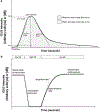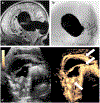Contrast-enhanced ultrasound of the pediatric brain
- PMID: 33599780
- PMCID: PMC11458139
- DOI: 10.1007/s00247-021-04974-4
Contrast-enhanced ultrasound of the pediatric brain
Abstract
Brain contrast-enhanced ultrasound (CEUS) is an emerging application that can complement gray-scale US and yield additional insights into cerebral flow dynamics. CEUS uses intravenous injection of ultrasound contrast agents (UCAs) to highlight tissue perfusion and thus more clearly delineate cerebral pathologies including stroke, hypoxic-ischemic injury and focal lesions such as tumors and vascular malformations. It can be applied not only in infants with open fontanelles but also in older children and adults via a transtemporal window or surgically created acoustic window. Advancements in CEUS technology and post-processing methods for quantitative analysis of UCA kinetics further elucidate cerebral microcirculation. In this review article we discuss the CEUS examination protocol for brain imaging in children, current clinical applications and future directions for research and clinical uses of brain CEUS.
Keywords: Brain; Children; Contrast-enhanced ultrasound; Epilepsy; Hypoxic–ischemic injury; Neurovascular disease; Stroke; Tumor; Ultrasound; Ultrasound contrast agents.
© 2021. The Author(s), under exclusive licence to Springer-Verlag GmbH, DE part of Springer Nature.
Conflict of interest statement
Figures






References
-
- Vinke EJ, Kortenbout AJ, Eyding J et al. (2017) Potential of contrast-enhanced ultrasound as a bedside monitoring technique in cerebral perfusion: a systematic review. Ultrasound Med Biol 43:2751–2757 - PubMed
-
- Archer LN, Levene MI, Evans DH(1986) Cerebral artery Doppler ultrasonography for prediction of outcome after perinatal asphyxia. Lancet 2:1116–1118 - PubMed
-
- Hwang M, Sridharan A, Darge K et al. (2019) Novel quantitative contrast-enhanced ultrasound detection of hypoxic ischemic injury in neonates and infants: pilot study 1. J Ultrasound Med 38: 2025–2038 - PubMed
-
- Prada F, Bene MD, Fornaro R et al. (2016) Identification of residual tumor with intraoperative contrast-enhanced ultrasound during glioblastoma resection. Neurosurg Focus 40:E7 - PubMed
Publication types
MeSH terms
Substances
Grants and funding
LinkOut - more resources
Full Text Sources
Other Literature Sources

